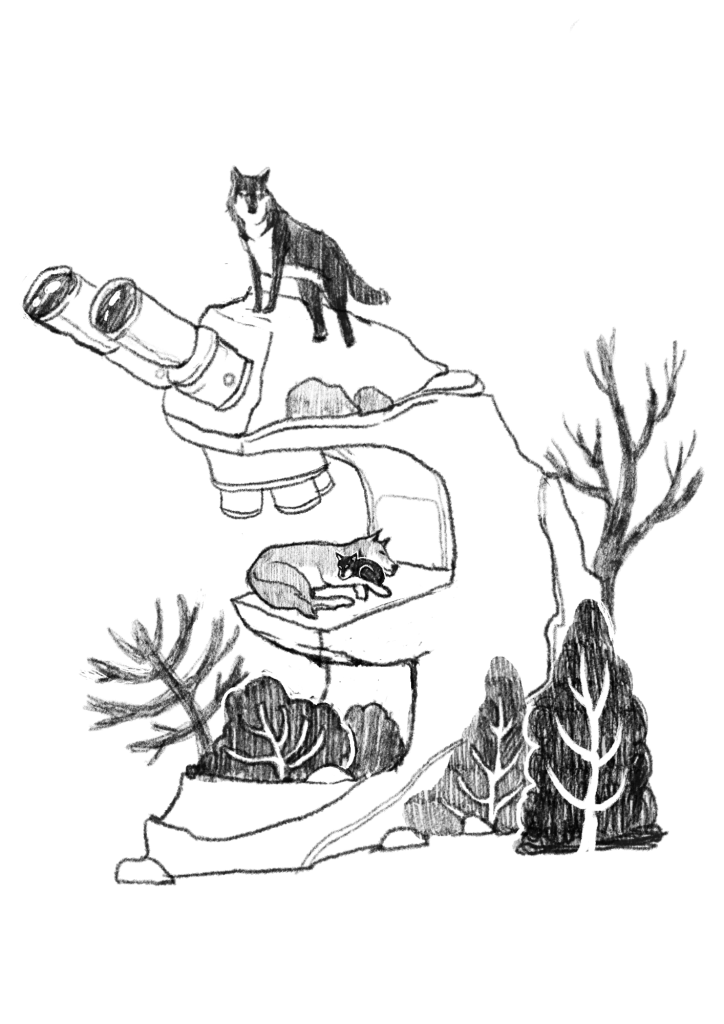Q). What are your most striking memories from your time in Kanha?
My wife Kay, two very young sons, and I lived for over a year in Kanha at the edge of a beautiful maidan in a bungalow that the government of Madhya Pradesh had generously allowed us to use. There we could observe chital, blackbuck, gaur and other species, and at times a tiger passed by our bungalow. I had learned to recognize the resident tigers individually by the stripe pattern on their face, and every meeting with an old ‘friend’ added data and pleasure to the project.
Q). How & why did you decide to work in India?
I had completed a mountain gorilla project in the Congo. The Johns Hopkins Center for Medical Research and Training, based in Baltimore and Calcutta, had an ecological unit which they asked me to join, and from late 1963 to 1965 we moved to India. Having read many shikar books about India, I was eager to actually study the actual lives of the various species.
Q). Could you share a couple of your experiences that have left an imprint on you from your time in the field?
Animals tend to be shy because people have made them afraid. I treasure experiences in which animals accept my presence without fear. Meeting a mountain gorilla group day after the day, the animals accepted me to such an extent that I could sleep near them while they were on their nests at night and one day a female climbed a tree, which I had ascended to observe them better, to sit beside me on a branch. Earlier this year, I was in Argentina, where on a ranch a group of capybara, the world’s largest rodents, an animal weighing 100 pounds, surrounded me within touching distance as I reclined among them. Such instances lift the spirit.
Q). Was conservation always the motivation for your research or it came about later your life?
I enjoy watching animals, delve into their lives. My early studies on gorillas, tigers, and lions were mostly in national parks where they and their habitats were fairly well protected. But even in the 1960s, I became well aware of the conflicting demands of conservation, development, and the livelihood of local people. In recent decades, I have focused more on species and conservation issues both inside and outside of reserves, on whole landscapes.
Solid scientific information is essential to protect and manage a species or area on a long-term basis. Without good information, government departments may out of ignorance or political expediency pass regulations and laws that actually harm the environment. One of my aims in recent years has been to offer data to governments on specific issues that may help them in making decisions.
Q). I am sure there wouldn’t be one solution but what would be your blueprint for conservation?
Mahatma Gandhi had two precepts that need to be in every blueprint for conservation:
- a) “There is enough in the world for everyone’s need but not enough for everyone’s greed;” and b) “You have to be the change you want to see in the world.”

Q). Problems of hunting/poaching are many-a-times linked to issues of food security or livelihoods/sustenance, how do you think developing countries should look at this issue?
Some illegal hunting is simply to make money by a few individuals or organized gangs. A good example is the killing of tigers in India for the trade in traditional medicines, especially to China. It’s a matter of law enforcement at all levels, yet in country after country– Cambodia, Laos, Vietnam, Myanmar—the flaming beauty of the tiger has vanished or will soon do so. The days of when the Maharaja of Surguja could brag about having killed 1150 tigers are gone, but India now has fewer than 2000, and with carelessness it could lose those as well. And then there is the mass-killing of the Tibetan antelope or chiru on the Tibetan Plateau in China to which India contributed for years by processing the fine wool of the animal to weave the ultra-fine shahtoosh shawls in Kashmir. The wool of some 300,000 chiru was for years illegally imported into India since the 1980s and knowingly processed before anything was done to halt it. The trade continues at a reduced rate.
The world’s religious community has been surprisingly negligent in promoting conservation. Every imam, minister, monk, and other should constantly emphasize that the ecological crisis is a moral issue, that all species have a right to exist, that the earth has limits that are being reached. The religion which is most explicit about conservation is Buddhism: “Kindness to all living beings is the true religion.”
The various faiths best become partners and vigorously promote the survival of humanity and all living beings on this small and fragile planet. Equally negligent in promoting conservation have been the media, the newspapers, magazines, radio, TV, or social network. The average Indian newspaper has several pages of cricket and no news about the environment. Worldwide, newspapers say little about the environment, whether we talk of small-town newspapers or the New York Times. Every newspaper, for example, should have at least one page daily on the environment, both good and bad news, to raise awareness about the beauty of the land and its problems and to arouse compassion and respect for animals and plants. The public needs to be more aware of its natural and cultural heritage and not be seduced by proclamations of endless growth, by GDP (which does not measure destruction and the death of nature), as currently promoted in India and the USA. Those who vote must think of the future.
Q). Problems of hunting/poaching are many-a-times linked to issues of food security or livelihoods/sustenance, how do you think developing countries should look at this issue?
Some illegal hunting is simply to make money by a few individuals or organized gangs. A good example is the killing of tigers in India for the trade in traditional medicines, especially in China. It’s a matter of law enforcement at all levels, yet in country after country– Cambodia, Laos, Vietnam, Myanmar—the flaming beauty of the tiger has vanished or will soon do so. The days when the Maharaja of Surguja could brag about having killed 1150 tigers are gone, but India now has fewer than 2000, and with carelessness, it could lose those as well. And then there is the mass-killing of the Tibetan antelope or chiru on the Tibetan Plateau in China to which India contributed for years by processing the fine wool of the animal to weave the ultra-fine shahtoosh shawls in Kashmir. The wool of some 300,000 chiru was for years illegally imported into India since the 1980s and knowingly processed before anything was done to halt it. The trade continues at a reduced rate.
In the rainforest of Amazon in Brazil where I have, in the recent years. been working, some indigenous tribes kill wildlife to eat because there is little other protein. But they, as well as settlers and some missionaries, sell the meat and hides in town to make money, and this makes any management of wildlife resources on a sustained basis impossible.
Actually in working with communities one can, as has been shown, regulate hunting and make it sustainable. There are options in offering income, such as paying local people to patrol and protect the land from intruders, local handicraft industry, resettlements with jobs and so forth, depending on the local situation. Whatever is done, government departments, NGOs, scientists, and communities need to collaborate to find solutions. Ultimately, however, no matter what the laws or implementations, it is the communities who will determine their tomorrow by truly working together to protect and manage the health of their land, and in a peaceful manner confront any issue that threatens their environment such as an unnecessary road, dam, timber operation, or other.
Q). How is it to work with different governments? Are politicians/bureaucrats the same across cultures/countries?
Politicians and bureaucrats are much the same everywhere, much concerned about retaining power and not making what might be considered a wrong decision. Few at the highest level of government have great interest in or concern for the environment—Indira Gandhi was an exception—but I have usually found officials in almost every of the 30 or so countries where I have done fieldwork who cared and were supportive. A new generation or two has had ecological training in India, as at the Wildlife Institute of India in Dehradun and the Centre of Wildlife Studies at the National Centre of Biological Sciences in Bangalore, or at overseas universities. This has created a core of dedicated and knowledgeable conservationists of great benefit to India.
When I visited, for example, the Kaziranga and Pakke national parks in 2017, I was much impressed by the directors and their staff who not only conduct research but also involve the surrounding communities in conservation, as well as providing the benefits in the form of a percentage of the park entrance fees paid by tourists. China, where I have worked annually since 1980, has made tremendous progress, training many conservation biologists in the country and abroad, setting up protected areas, and creating management plans for critical areas to reduce the ecological impact in cooperation with communities.
My main goal, now as always, has been to help the country if possible by collecting information that in some way can be of use to conservation.
Q). When it comes to policy or laws, a country like India has some of the best legal frameworks but dismal implementation. How do you think this affects conservation/protection and what should be rectified?
Governments at all levels everywhere have to decide if they want an environmentally healthy future for their people. An excuse always is a lack of money. But it’s a matter of how the available money is spent, the environment being usually of low priority. The public needs to be educated, and that’s a job of schools, churches, and other such institutions– and the media. And then the public must pressure the government to change, amend, or implement the laws for the future benefit of everyone, not just corporations and other ‘big businesses’ which are all too successful in buying what they want from politicians and bureaucrats. Easier said than done! But be aware of what is happening. Brazil, for instance, is planning to build 304 dams on the rivers of the eastern Amazon, a development that will have a huge impact on everything from climate to new roads, settlers, destruction of forests, and others. Of these, 46 dams have already been built. Responses to these plans have been surprisingly muted.
Q). Where do you see the world is headed in the next 50 years?
In the last 50 years, we have used up more of the planet’s resources than in all previous history. We tend to forget three matters:
Every personal act is also an ecological act with an impact on the environment, whether we drink a cup of tea or send an email. Everything in nature is connected and interrelated, indicating that we can not address anything in isolation. Everything we make, buy, need, and use comes from nature, and at the rate, we are continuing to destroy things mindlessly makes me wonder if there is intelligent life on earth. So we best not plan the future as in the past, and it’s certainly ours to improve or lose all.







